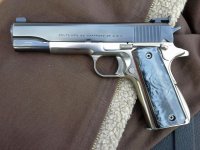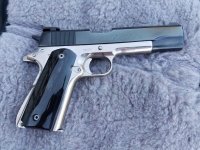rhmc24
Absent Comrade
I've often wondered why the Colt .38 Super in the first place, considering hazard when used in the many thousands of their 1900s, 1902s & 1903Hs out in public hands.
Need to perforate car bodies might have been met by a bottle-neck .45ACP to .38 or .40 ACP.
Colt was very adept at hybrid gun re-configuring the 1900s .38 Smokeless series with minimal 1911 change to become the 1905 .45 cal -- so why not just a barrel & mag design change to get more velocity it needed in the hundred-Ks of 1911 WW1 survivors out there.
My suspicion is that Colt Marketing deliberately obsoleted the .38 auto by its same cartridge on steroids, the now dangerous .38 Super wih physical intrchangeability. Same Marketing suspicion Colt avoided the change of cartridge, barrel & mag, a simple conversion of the 1000s of WWI bring-backs that would stymie the sale of 1911s renamed .38 Super.
All this in the 1930s mindset of very few people interested in or equipped for DIY as exists today, recaling a 1930s gunsmith's thrill finally getting a lathe -- even though it was a foot treadle powered one from the 1860s that only turned, no threading ----->
Need to perforate car bodies might have been met by a bottle-neck .45ACP to .38 or .40 ACP.
Colt was very adept at hybrid gun re-configuring the 1900s .38 Smokeless series with minimal 1911 change to become the 1905 .45 cal -- so why not just a barrel & mag design change to get more velocity it needed in the hundred-Ks of 1911 WW1 survivors out there.
My suspicion is that Colt Marketing deliberately obsoleted the .38 auto by its same cartridge on steroids, the now dangerous .38 Super wih physical intrchangeability. Same Marketing suspicion Colt avoided the change of cartridge, barrel & mag, a simple conversion of the 1000s of WWI bring-backs that would stymie the sale of 1911s renamed .38 Super.
All this in the 1930s mindset of very few people interested in or equipped for DIY as exists today, recaling a 1930s gunsmith's thrill finally getting a lathe -- even though it was a foot treadle powered one from the 1860s that only turned, no threading ----->






